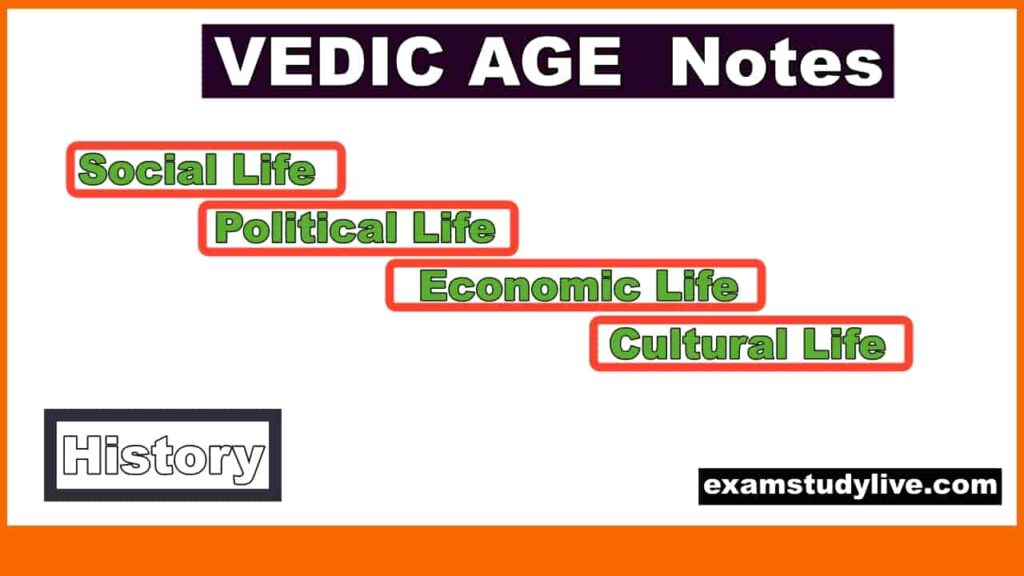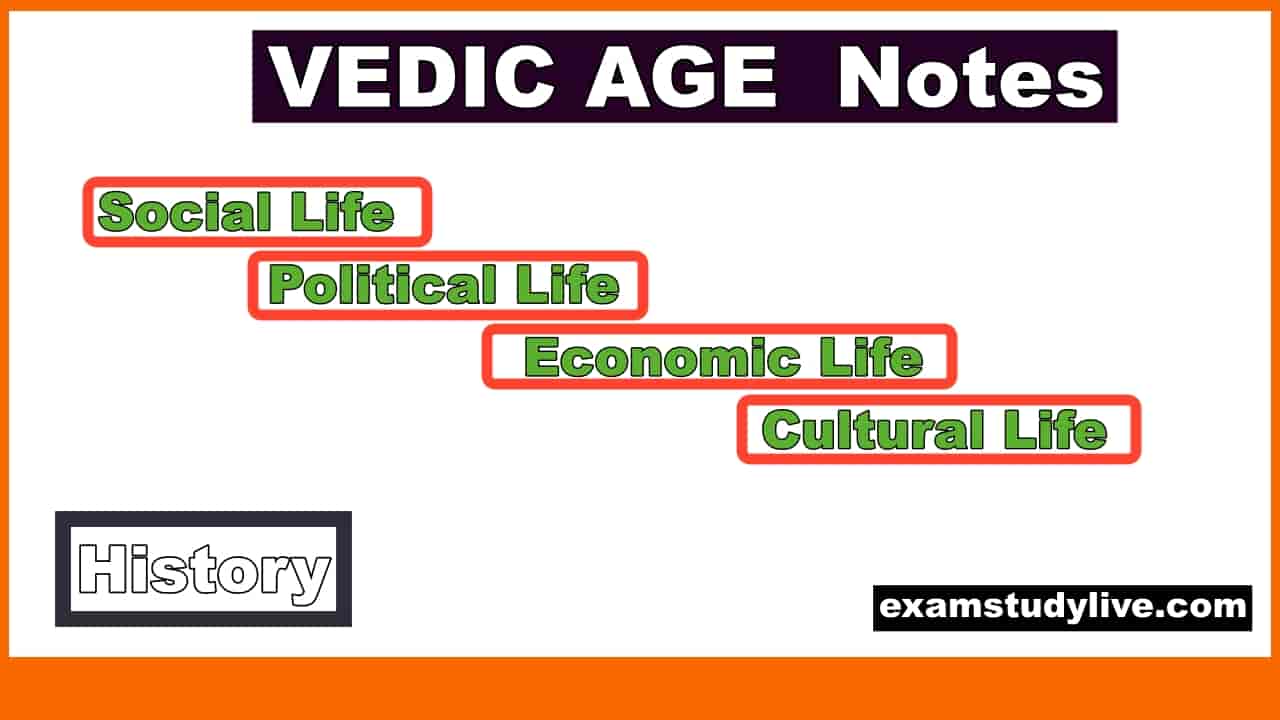VEDIC AGE (1500BC-600BC)
The word Veda comes from the root “Vidi” which means knowledge. The people of Vedic age were Aryan. It means a newcomer. They were not originally inhabited.

Dravidian was the original habitat in India. They were seminomadic people. They came to India through Khyber Pass. According to different historians the original home of Aryan as:
Dayananda Saraswati -Tibet, Prof Penka -German Plain BG Tilak- Arctic region, Prof MC Donnel -Austria- Hungry Dr. A C Das-Sapta Sindhu, Prof Max. Muller -Central Asia. They settled in India called ‘Land of seven rivers’ or Sapta Sindhava.
Sindhu- Indus Vitasta-Jhelum
Asikini-Chenab
Purushini-Ravi
Vipasa-Ravi
Satudri-Sutlej
Saraswati- Ghaggar
Also Read this: What is Prehistory – Paleolithic, Neolithic & Mesolithic Age Notes
Also students know about Vedic civilization
EARLY VEDIC AGE (1500 B.C-1000 BC)
Social Life
The family was the basic unit of society in Vedic age. The family was patriarchal. It means the head of the family was male but women enjoyed equal power with men. Marriage was usually monogamous.
But there was evidence of widow marriage. The Aryan loved music and played the flute. There were references to signing and dancing. People delighted in gambling and enjoyed chariot racing. Both men and women having ornaments.They believed in the system of ‘Chaturashrama’1. Brahmacharya2. Grahasthya3. Vanaprastha4. Sanyasa
Political Life
Kula or family was the basic social unit. Kulapa was the head of the family. Gramani was the head of the village was there was monarchical form. The king was known as Rajan. He was the leader of the battle and protector of the tribe.
He was arrested by a member of officers like Purohita, Senani, and Gramani. Sabha and Samiti are two important assemblies during the early Vedic age.
Sabha was the upper house with learned and noble persons and Samiti was the lower house with common people.
Economic Life
Agriculture was the chief occupation of early Vedic people. 2nd occupation was cattle rearing. Cattle was the chief measure of wealth and people having more cattle assumed as wealth by man.
Cow was the standard unit of exchange. There was shifting cultivation and there was no concept of private property.
Religious Life
The most important god of Aryan was Indra. He was known as Purandar or the breaker of the fort.
He was associated with storms and thunder. 250 hymns were attributed to him.
Agni is known as the god of fire. He occupied the second position. 200hymns attributed to him. Agni was the mediator between God and humans.
Varuna is called the god of water. It occupied the third position. He was supposed to uphold the highest of all gods. The other gods were:Soma- God of plants.Vavu-God of winds, Aditi -mother of god, Pruthvi -Earth goddess, Yoma-God of dead bodies
LATER VEDIC AGE (1000BC-600BC)
Social Life
The society of the Later Vedic Period was rigid. There was child marriage, polygamy dowry system, and Purdah system. The woman lost their importance. The four-fold division of society became very clear.1. Brahmin 2. Kshatriya 3.Vaishya 4. Sudra It was initially based on the occupation which later became hereditary. Gotra which signified descent appeared during this time. People knew the use of iron during this time.
Political Life
The term ‘ Rashtra’ anneared first during this time. Powers were vested on kings. The importance of A regular army was maintained for the protection of the kingdom.
Religious Life
Brahma, Vishnu, and Maheswar became the supreme deity. Brahma called Praianati – the creator. Vishnu- known as preserver and Maheswar is known as the destroyer. Indra and Agni lost their importance during the later Vedic age.
IMPORTANT OF VEDIC AGE
The importance of the Vedic age within its Vedic literature. It was with its 4 Vedas, 4 Upavedas, Upanishads, Darshanas, Epics, Vedangas, Aranyakas, Smritis, and Puranas.
Veda
Vedas are 4 in number
Rigveda
- It is the oldest Veda.
- It consists of 1028 hymns.
- It divided into 10 Mandalas.
- It is the collection of hymns of prayers.
- Gayatri Mantras is the greatest hymns of Rig Veda Recited by priest Hotri.
San Veda
- It is the collection of 1875 hymns. It is the oldest text on Indian music.
- It is a collection of melodies.
- It is the stone house of the knowledge of chants.
- It is important for Indian music.
- Recited by priest Udagotri
Yajur Veda
It is the connection of 760 hymns. It is a prose Veda. It deals with rituals and sacrifice. It divided into:(a) Black Yajurveda (unarranged)(b) White Yajurveda (arranged)
Recited by Advaryus
Atharva Veda
- It is the connection of 730 hymns.
- It is regarded as non-Aryan Veda. It deals with a magical formula.
- It contains charms and spells.
- It is often called the fourth Veda.
Upaveda
Parts of Veda also called Auxullary Veda. There are four types of Upaveda.1. Ayurveda – Rig Veda – Deals with Medicine2. Gandharva Veda – Sam Veda -Deals with Music3. Dhanurveda – Yajur Veda – Deals with War4. Silpaveda – Atharva Veda – Decking with making idols
Upanishad
- It is also called Vedanta. It means to sit someone to get knowledge.
- There are 108 Upanishads in total.
- Mundaka Upanishad, Jabala Upanishad, Katha Upanishad, and Tatriva Upanishad are important Upanishads.
Mundaka Upanishad gives Satyameva Jayate Jabala Upanishad tells four Ashrams of life Katha Upanishad – It is the conversation between Yoma and Nachiketa.Trivia Unanishad gives important information about Atithi Deva Bhava.
Darshana(Philosophy)
There are six schools of Indian philosophy
- Nyaya means analysis by Gautama
- Sankhya means enumeration by Kapila
- Veda means practice and application of Patanjali
- Vaishesika means the study of individual characteristic by Kannada
- Purva Mimansa means inquiry by Jamini
- Uttara Mimansa means a critical examination by Vyasa
The oldest philosophy -Sankhya The youngest philosophy- Yoga
Vedanga(Limb of Veda)
There are six Vedangas in total
- Shiksha means phonetics-Deals with pronunciation
- Kalpa means rituals-Deals with religious ceremony or sacrifice
- Vyakarana means grammar -Deals with linguistic analysis
- Nirukta means etymology -Deals with an explanation of words
- Chhanda means prosody-Deals with poetic composition
- Jyotisha means astrology – Deals with auspicious time for rituals
Pratishakhyas by Shaunka – The Oldest text of phonetics Ashtadyayi by Panini – The oldest grammar book Nirukta by Yoska -The oldest dictionary of the world Chhanda sutra by Pingala – The oldest poetic composition Vedanga Jvotisha by Lagadh Muni – The oldest Jyotish text
Purana
There are 18 purana’s.
- Vyasa considers as the compiler of Purana.
- It literary means ancient old.
- It is named after major Hindu deities like Vishnu Shiva and Agni etc.
- Skanda Purana is the longest Purana.
- Garuna and Kurma are shortest puranas.
- Matsya Purana and is the oldest Purana
- Agni Purana is the youngest Purana text.
Epic
There are two epics
- Mahabharata – divided into 18 parts. It is written by Vyasa with the help of Ganesh.
- Ramayan – divided into 7 parts. It is written by Valmiki
Brahmana
Brahmana means sacrifice It explains the hymns of Veda in an orthodox manner. several Brahmans attached to Each Veda.1. Rig Veda– Koushitaki and Aitreya2. Sam Veda-Tandyamaha and jaiminiya3. Yajur Veda-Satpatha Brahmana and Taitreya Brahmana4. Atharv Veda-Gopatha Brahmana
Smriti
It explains rules and regulations in Vedic life. Important smritis are:
- Manu Smriti
- Narada Smriti
- Parashara Smriti
Aranyaka
It is called a forest book. These are mainly written by the hermits living in the jungles with their pupils.
Aranyaka are the concluding portions of the Brahmanas. Deals with philosophy and opposed to sacrifice and emphasize meditation. It forms a bridge between the way of work (Karma Marg) which was the sole concern of Upanishad and the way of knowledge ( Gyana Marg) which the Brahmanas advocated.
Marriage
There are eight types of marriage according to Hinduism these are:
- Brahma Marriage – Marriage with a dowry
- Daiva marriage – Inferior marriage – Waiting for marriage
- Arsha marriage – Agasthya vs Lopamudra – A marriage to a sage
- Prajapatya marriage – Marriage without dowry
- Gandharva marriage – Love marriage
- Asura – Marriage by purchase
- Rakshasa – Marriage by capture
- Paishacha – Marriage by seduction/rape
According to caste, there are two marriages.
1. Anuloma – Higher caste man & lower caste woman2. Pratiloma – Lower caste man & higher caste women.

